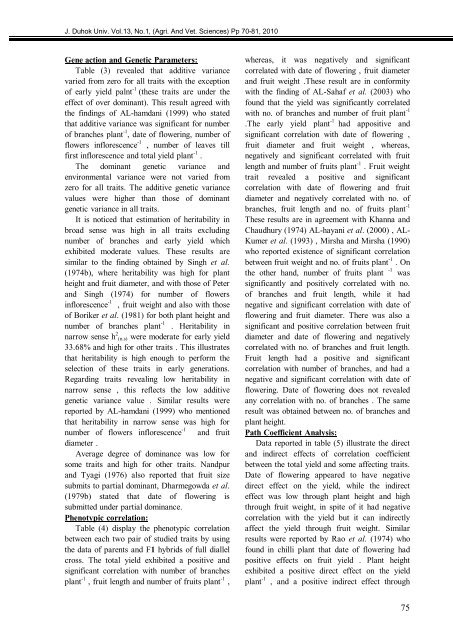The Influence Of Priming Two Cucumber Cultivar Seeds
The Influence Of Priming Two Cucumber Cultivar Seeds
The Influence Of Priming Two Cucumber Cultivar Seeds
You also want an ePaper? Increase the reach of your titles
YUMPU automatically turns print PDFs into web optimized ePapers that Google loves.
J. Duhok Univ. Vol.13, No.1, (Agri. And Vet. Sciences) Pp 70-81, 2010<br />
Gene action and Genetic Parameters:<br />
Table (3) revealed that additive variance<br />
varied from zero for all traits with the exception<br />
of early yield palnt -1 (these traits are under the<br />
effect of over dominant). This result agreed with<br />
the findings of AL-hamdani (1999) who stated<br />
that additive variance was significant for number<br />
of branches plant -1 , date of flowering, number of<br />
flowers inflorescence -1 , number of leaves till<br />
first inflorescence and total yield plant -1 .<br />
<strong>The</strong> dominant genetic variance and<br />
environmental variance were not varied from<br />
zero for all traits. <strong>The</strong> additive genetic variance<br />
values were higher than those of dominant<br />
genetic variance in all traits.<br />
It is noticed that estimation of heritability in<br />
broad sense was high in all traits excluding<br />
number of branches and early yield which<br />
exhibited moderate values. <strong>The</strong>se results are<br />
similar to the finding obtained by Singh et al.<br />
(1974b), where heritability was high for plant<br />
height and fruit diameter, and with those of Peter<br />
and Singh (1974) for number of flowers<br />
inflorescence -1 , fruit weight and also with those<br />
of Boriker et al. (1981) for both plant height and<br />
number of branches plant -1 . Heritability in<br />
narrow sense h 2 (n.s) were moderate for early yield<br />
33.68% and high for other traits . This illustrates<br />
that heritability is high enough to perform the<br />
selection of these traits in early generations.<br />
Regarding traits revealing low heritability in<br />
narrow sense , this reflects the low additive<br />
genetic variance value . Similar results were<br />
reported by AL-hamdani (1999) who mentioned<br />
that heritability in narrow sense was high for<br />
number of flowers inflorescence -1 and fruit<br />
diameter .<br />
Average degree of dominance was low for<br />
some traits and high for other traits. Nandpur<br />
and Tyagi (1976) also reported that fruit size<br />
submits to partial dominant, Dharmegowda et al.<br />
(1979b) stated that date of flowering is<br />
submitted under partial dominance.<br />
Phenotypic correlation:<br />
Table (4) display the phenotypic correlation<br />
between each two pair of studied traits by using<br />
the data of parents and F1 hybrids of full diallel<br />
cross. <strong>The</strong> total yield exhibited a positive and<br />
significant correlation with number of branches<br />
plant -1 , fruit length and number of fruits plant -1 ,<br />
whereas, it was negatively and significant<br />
correlated with date of flowering , fruit diameter<br />
and fruit weight .<strong>The</strong>se result are in conformity<br />
with the finding of AL-Sahaf et al. (2003) who<br />
found that the yield was significantly correlated<br />
with no. of branches and number of fruit plant -1<br />
.<strong>The</strong> early yield plant -1 had appositive and<br />
significant correlation with date of flowering ,<br />
fruit diameter and fruit weight , whereas,<br />
negatively and significant correlated with fruit<br />
length and number of fruits plant -1 . Fruit weight<br />
trait revealed a positive and significant<br />
correlation with date of flowering and fruit<br />
diameter and negatively correlated with no. of<br />
branches, fruit length and no. of fruits plant -1<br />
<strong>The</strong>se results are in agreement with Khanna and<br />
Chaudhury (1974) AL-hayani et al. (2000) , AL-<br />
Kumer et al. (1993) , Mirsha and Mirsha (1990)<br />
who reported existence of significant correlation<br />
between fruit weight and no. of fruits plant -1 . On<br />
the other hand, number of fruits plant -1 was<br />
significantly and positively correlated with no.<br />
of branches and fruit length, while it had<br />
negative and significant correlation with date of<br />
flowering and fruit diameter. <strong>The</strong>re was also a<br />
significant and positive correlation between fruit<br />
diameter and date of flowering and negatively<br />
correlated with no. of branches and fruit length.<br />
Fruit length had a positive and significant<br />
correlation with number of branches, and had a<br />
negative and significant correlation with date of<br />
flowering. Date of flowering does not revealed<br />
any correlation with no. of branches . <strong>The</strong> same<br />
result was obtained between no. of branches and<br />
plant height.<br />
Path Coefficient Analysis:<br />
Data reported in table (5) illustrate the direct<br />
and indirect effects of correlation coefficient<br />
between the total yield and some affecting traits.<br />
Date of flowering appeared to have negative<br />
direct effect on the yield, while the indirect<br />
effect was low through plant height and high<br />
through fruit weight, in spite of it had negative<br />
correlation with the yield but it can indirectly<br />
affect the yield through fruit weight. Similar<br />
results were reported by Rao et al. (1974) who<br />
found in chilli plant that date of flowering had<br />
positive effects on fruit yield . Plant height<br />
exhibited a positive direct effect on the yield<br />
plant -1 , and a positive indirect effect through<br />
07



